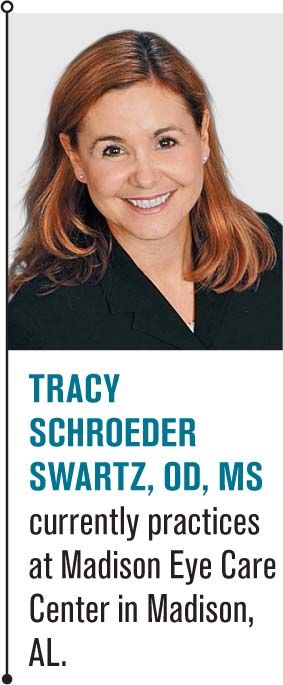Cosmetic dangers: Part 2-Products banned by the FDA, worsen ocular surface disease
In Part 2 of her three-part series on cosmetic dangers, Tracy Schroeder-Swartz, OD, MS, FAAO, focuses on the dangers found in cosmetics-particularly cosmetics banned by the FDA and those that may exacerbate ocular surface disease.


The views expressed here belong to the author. They do not necessarily represent the views of Optometry Times or UBM Medica.
Many times, we read the label of our cosmetics and wonder what exactly a certain ingredient may be. Our patients use a variety of cosmetics on their faces and around their eyes, and it is important to be aware of the products that are coming into contact with their periocular skin.
In Part Two of this three-part series, I focus on dangers found in cosmetics, particularly ingredients banned by the FDA and those that will exacerbate ocular surface disease (OSD). Not everyone may use every product on my cosmetics list, but it is valuable to understand what is in the cosmetic products patients may be using.
Previously from Dr. Schroeder-Swartz: Cosmetic dangers: Part 1-Popular cosmetics patients use
Currently banned substances
The FDA has banned the use of the following substances in cosmetics:1
• Bithionol: May cause photocontact sensitization; an increased reaction to ultraviolet (UV) light.
• Chlorofluorocarbon propellants: Ozone depleting; application may result in dermatitis and dry skin.2
• Chloroform: Carcinogenic to animals; damaging to human tissues.
• Halogenated salicylanilides (di-, tri-, metabromsalan and tetrachlorosalicylanilide): May cause serious skin disorders and photosensitivity.
• Hexachlorophene: Repeated or prolonged skin contact may cause dermatitis and skin sensitization.
• Mercury compounds: Readily absorbed through the skin when used topically. Tends to accumulate after repeated use. May cause allergic reactions, skin irritation, or neurotoxic problems. Use of mercury compounds in eye cosmetics is limited to no more than 65 parts per million (0.0065 percent) of mercury calculated as the metal.
Related: 7 tips for safer lens wear with cosmetics
• Methylene chloride: Carcinogenic in animal testing.
• Prohibited cattle materials: Cosmetics may not be manufactured from, processed with, or otherwise contain prohibited cattle materials to protect against bovine spongiform encephalopathy (BSE) or “mad cow disease.”
• Vinyl chloride: Exposure causes central nervous system effects, liver damage, and cancer.
• Zirconium-containing complexes: Causes toxic effect on the lungs in animal testing and granulomas in human skin.
Ingredients not banned but questionable
The FDA website lists the following ingredients with links for more safety information, but it has not banned them from being used in products:3
• Alpha hydroxy acids (AHA): Exfoliative for wrinkles and fine lines. Repeated application causes increased UV sensitivity. Reports of burning, dermatitis, edema, pigmentary changes, welts, skin peeling, itching, chemical burns, and increased sunburn risk are documented.4
• Beta hydroxy acids: Less irritating than AHA’s and may be listed as salicylic acid, salicylate, sodium salicylate, citric acid, tropic acid, trethocanic acid, and willow extract. Have been reported to increase photosensitivity.
• Color additives: Permitted in cosmetics only if the FDA has approved them for the intended use. Some may be used only if they are from FDA-tested and certified batches.5
• Diethanolamine: Short-term inhalation exposure to diethanolamine in humans may cause irritation of the nose and throat; skin exposure may cause dermatitis.
• Fragrance: Product labeling determines if the inclusion of fragrance means the product is a drug or cosmetic.
• Parabens: Preservative used in cosmetics. The FDA treats preservative like other ingredients and does not address animal or human studies investigating risk on the FDA website.
• Phthalates: The FDA site addresses surveys from 1998 to 2006. It concluded the number of phthalates in cosmetics has decreased since 2004 and pose no threats to humans. The Centers for Disease Control and Prevention (CDC) fact sheet reports some phthalates affect the reproductive system of laboratory animals, but more research is required to assess the human health effects of exposure.6
• Talc (hydrous magnesium silicate): May contain the carcinogen asbestos.
Related: Preparing the periocular region for surgery
Banned cosmetic substances elsewhere
Several countries have banned substances from cosmetic that are acceptable to the U.S. FDA standards. In Europe, the following substances are banned from use in cosmetics:
• Formaldehyde
• Triphenyl phospohate (TPHP): Disrupts hormones.
• Petroleum: Long-term use is linked to cancer.
• Propyl paraben: Associated with reduced fertility; estrogenic.
• Fragrance: Often how proprietors hide secret or unnamed ingredients.
• Hydroquinone: Skin-lightening crème is cytotoxic and kills cells and chromosomes.
• Phthalates: Hormonal disruption in both men and women.
• P-Phenulenediamine: Coal tar derivative; may cause bad allergic reaction and sensitivity.
• Avobenzone: Chemical sunscreen is unstable and easily breaks down causing free radical cascade, early aging, and cancer.
• Oxybenzone: Chemical sunscreen has been linked to cancer in mice.
OSD more common in eye cosmetic wearers
Aside from what the FDA has deemed unsuitable, it is not surprising that OSD is more common among those who wear eye cosmetics. According to Ng et al, 53 percent of female respondents reported using at least three different eye cosmetic products regularly, and 65 percent reported a reduction in comfort when wearing eye cosmetics.7
Eye cosmetics migrate into the tear film when drops are instilled.8,9 Eyeliner applied inside the lash line contaminated the tear film less than eyeliner applied to periocular skin anterior to the lashes.7
Warnings regarding the use of eyeliner along the lid margin are increasing as we learn more about the importance of meibomian gland health over a lifetime. Some eyeliners may physically interact with meibum more than others.10
Related: Uncover patient lifestyle habits that lead to OSD
Substances known to worsen OSD
The following substances are known to exacerbate OSD (but may be considered safe for the facial skin and may not be banned substances):
• Benzalkonium chloride (BAK)
• Alcohol: Drying agent (and it stings).
• Retinaol/retinoids: Anti-aging products such as cis-retinoic acid has demonstrated toxicity to human meibomian glands in cell culture.11 Anti-aging creams containing retinoids may exacerbate ocular surface disease.12
• Parabens
• Isopropyl cloprostenate: Synthetic prostaglandin analogue which promotes inflammation. May be found in products for growing eye lashes.
• Formaldehyde
• Phenoxyethanol: Paraben substitute, it is a germicidal and germistatic glycol ether, phenol ether, and aromatic alcohol.2 Classified as an irritant for eyes, skin, and lungs by the European Union.
• Butylene glycol: Organic alcohol used as a solvent and a viscosity-decreasing agent in skin cremes.2
• Ethylenediaminetetra acetic acid (EDTA): If it burns off calcific band keratopathy, you do not want it near your meibomian glands.
• Argireline: Peptide which is similar to Botulinum toxin and promoted as Botox in a bottle.
You should now have a firm foundation on common cosmetic products your patients might be using and how these cosmetics may be complicating your patients OSD and contact lens wear. Part Three of this three-part series will focus on what you can do as an OD to educate your patients about their use of cosmetics.
References
1. U.S. Food and Drug Administration. Prohibited & Restricted Ingredients. Available at: https://www.fda.gov/Cosmetics/GuidanceRegulation/LawsRegulations/ucm127406.htm. Accessed 3/8/18.
2. Batema C. What Effects do Chlorofluorocarbons Have on Humans? Sciencing. Available at: http://sciencing.com/effects-chlorofluorocarbons-humans-7053.html. Accessed 3/8/18.
3. U.S. Food and Drug Administration. Products and Ingredients. Available at: https://www.fda.gov/Cosmetics/ProductsIngredients/default.htm. Accessed 3/8/18.
4. U.S. Food and Drug Administration. Alpha Hydroxy Acids. Available at: https://www.fda.gov/Cosmetics/ProductsIngredients/Ingredients/ucm107940.htm. Accessed 3/8/18.
5. U.S. Food and Drug Administration. Color Additives Permitted for Use in Cosmetics. Available at: https://www.fda.gov/Cosmetics/Labeling/IngredientNames/ucm109084.htm. Accessed 3/8/18.
6. Centers for Disease Control and Prevention. Phthalates Factsheet. Available at: https://www.cdc.gov/biomonitoring/phthalates_factsheet.html. Accessed 3/8/18.
7. Ng A, Evans K, North RV, Purslow C. Migration of Cosmetic Products into the Tear Film. Eye Contact Lens. 2015 Sep;41(5):304-9.
8. Wang MTM, Cho ISH, Jung SH, Craig JP. Effect of lipid-based dry eye supplements on the tear film in wearers of eye cosmetics. Cont Lens Anterior Eye. 2017 Aug;40(4):236-241.
9. Goto T, Zheng X, Gibbon L, Ohashi Y. Cosmetic product migration onto the ocular surface: exacerbation of migration after eyedrop instillation. Cornea. 2010 Apr;29(4):400-3.
10. Hunter M, Bhola R, Yappert MC, Borchman D, Gerlach D. Pilot study of the influence of eyeliner cosmetics on the molecular structure of human meibum. Ophthalmic Res. 2015;53(3):131-5.
11. Ding J, Kam WR, Dieckow J, Sullivan DA. The influence of 13-cis retinoic acid on human meibomian gland epithelial cells. Invest Ophthalmol Vis Sci. 2013 Jun 26;54(6):4341-50
12. Ding J, Sullivan DA. Aging and dry eye disease. Exp Gerontol. 2012 Jul;47(7):483-90.
Newsletter
Want more insights like this? Subscribe to Optometry Times and get clinical pearls and practice tips delivered straight to your inbox.





.png&w=3840&q=75)











